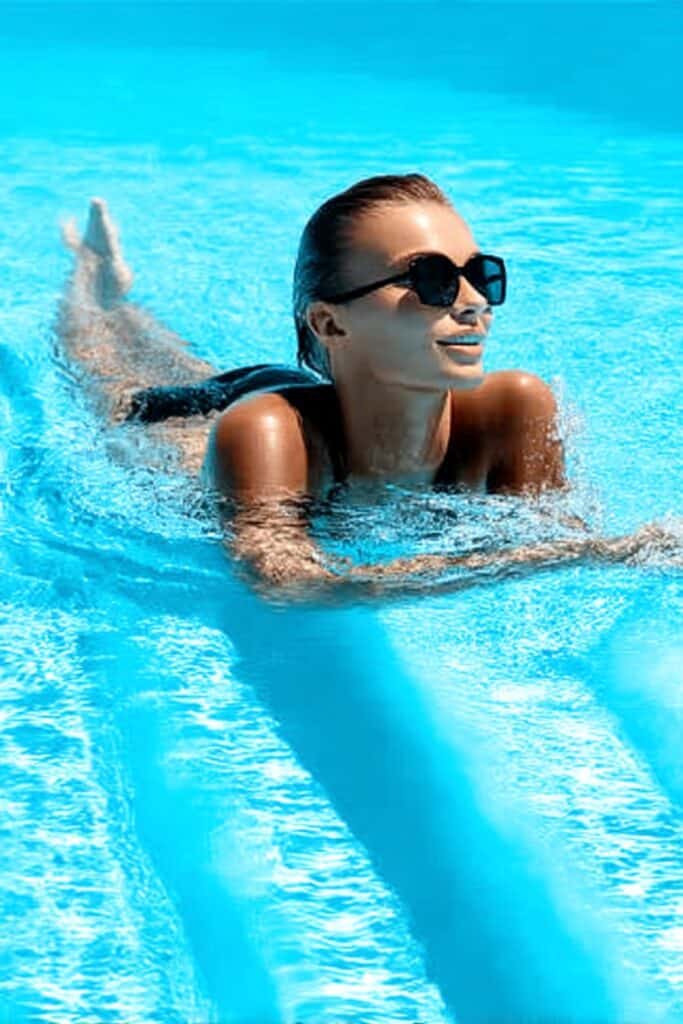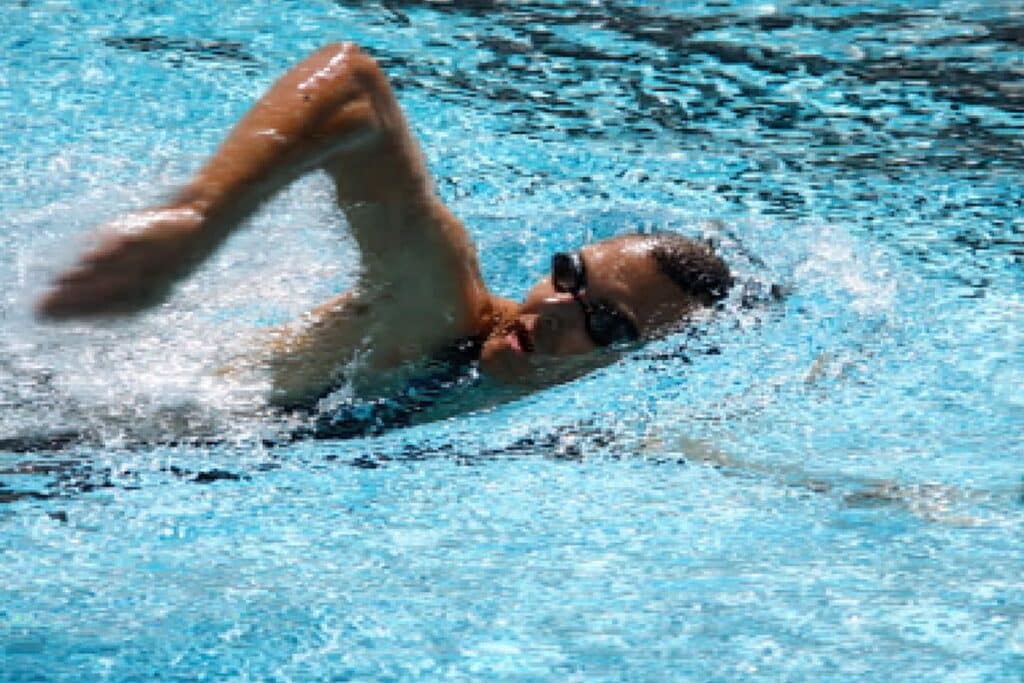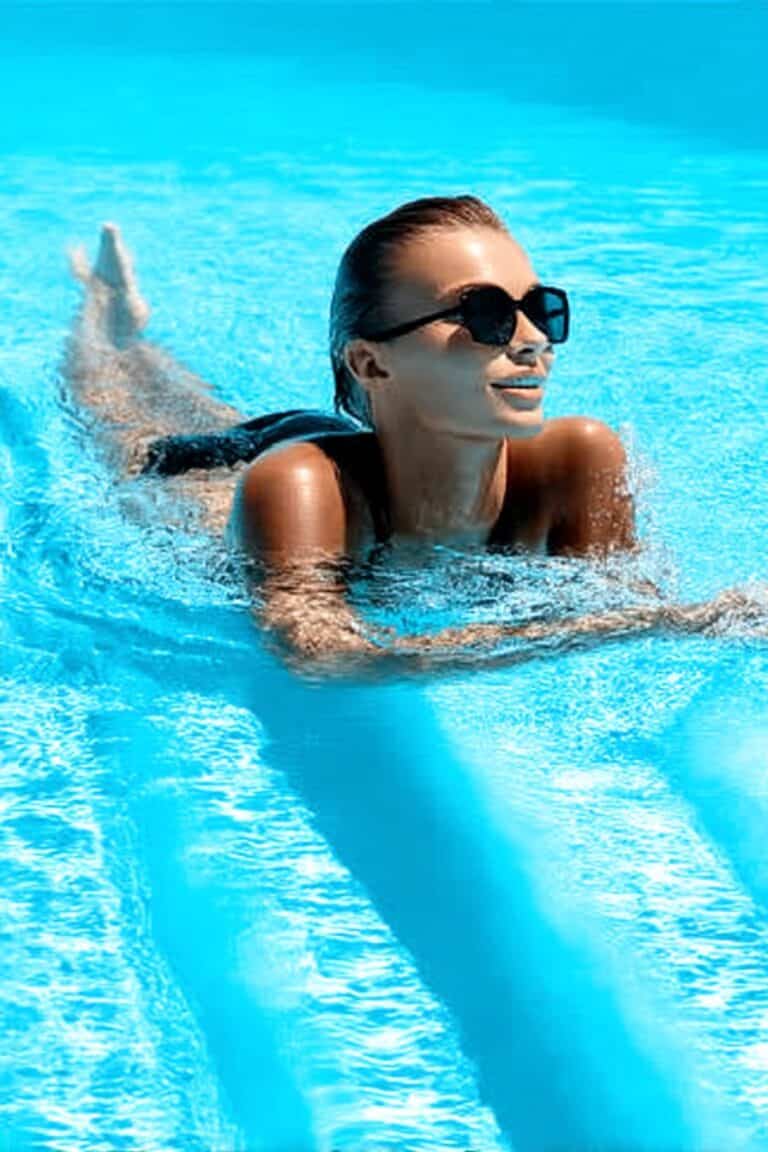
Swimming takes a heavy toll on your skin. My work as a professional makeup artist has exposed me to many clients who swim. I’ve witnessed how chlorine makes skin dry and irritated, and it can damage your skin over time.
Protecting swimmers’ skin requires more than just applying moisturizer after swimming. Dermatologists have confirmed that chlorinated water can cause irritant contact dermatitis. UV exposure during outdoor swimming also raises the risk of sun damage substantially. Your skin needs protection even before you jump in the pool.
Let me share my professional experience to help you create a skin care routine that works for swimmers. I’ll walk you through pre-swim preparation, post-swim recovery, and products that deliver results. You’ll learn how to shield your skin from chlorine damage and keep it healthy and glowing, whether you swim daily or just on weekends.
Pre-Swim Skin Prep That Actually Works

The battle between your skin’s pH and pool water starts well before you take your first lap. Swimming pools typically maintain pH levels above 7, which clashes with our skin’s natural pH of about 4.7. This difference disrupts our skin’s protective barrier right away and leads to dryness and irritation.
Why dry skin starts before you even tuck in
My years of working with athlete clients taught me that chlorine directly attacks sebum—the natural oil layer that protects your skin. Chlorine strips this defensive barrier, which lets moisture escape from your skin cells faster. This chemical exposure can also trigger inflammation that causes those red, scaly rashes swimmers tend to get.
A common myth I hear from clients suggests air-drying after swimming helps skin. This idea couldn’t be more wrong! Letting chlorinated water evaporate actually concentrates irritating chemicals on your skin and causes more damage.
My go-to barrier products and how I apply them
Both my clients and I have seen dramatic improvements by creating a protective shield before swimming. The best approach is to apply a thick barrier cream at least 15 minutes before pool time. Look for products with:
- Dimethicone (creates a true seal against chlorine)
- Glycerin or petrolatum (locks in moisture)
- Natural oils like jojoba or coconut (additional protection)
My application method starts with a quick shower using fresh water—wet skin absorbs less chlorine than dry skin. Next, I apply the barrier product generously to exposed areas and pay special attention to spots prone to eczema.
My competitive swimmers love DermaSwim Pre-Swimming Lotion or Exershield, which are specifically made to neutralize chlorine’s effects. Cicaplast Balm B5 offers excellent protection without feeling greasy as another solid option.
Choosing the right sunscreen for swimmers
Outdoor swimming demands extra attention to sunscreen as a protective barrier. Swimmers should look for products labeled “water resistant for 80 minutes”—the highest rating FDA regulations allow.
Mineral-based sunscreens with zinc oxide work better than chemical formulations. These create a physical barrier that’s gentler on skin and less likely to irritate eyes during swimming.
Your best protection comes from applying waterproof sunscreen generously 30 minutes before swimming, then adding another layer right before entering the water. This double application matters since most people use nowhere near enough sunscreen.
Good pre-swim preparation makes the real difference between damaged, irritated skin and keeping your natural glow—even with regular chlorine exposure.
What I Do Right After Swimming (And Why It Matters)

The first moments after climbing out of the pool can make or break your skin’s health. I learned this lesson the hard way through my work with competitive swimmers. Their skin showed severe damage despite using expensive products.
The first 5 minutes post-swim are everything
Your immediate actions after swimming determine chlorine’s impact on your skin. My clients and I never wait to get home before showering. Chlorine binds to skin proteins and stays there, which actively strips away natural oils. This process guides swimmers to experience that familiar tight, dry feeling.
A small towel stays in my swim bag to pat dry right away. In stark comparison to this, air-drying harms swimmers’ skin. Prominent dermatologists confirm that air-drying increases dryness as chlorinated water evaporates and concentrates these irritating chemicals.
How I rinse off chlorine without stripping my skin
My post-swim routine starts with a thorough warm water rinse. Hot water might feel good but damages your already compromised skin barrier. I focus extra attention on skin folds—behind knees, inner elbows—where chlorine tends to linger.
Experts debate using soap right after swimming. I skip harsh soaps initially since they add more chemicals to irritated skin. Plain water removes most chlorine first, followed by a gentle pH-balancing cleanser.
The gentle cleanser I swear by
The sort of thing I love about swimmer-specific cleansers is their ability to neutralize chlorine effectively. My clients’ experiences with dozens of products show remarkable results. I rely on cleansers with aloe vera and chamomile that remove chlorine while soothing irritated skin.
Products that restore your skin’s natural pH balance are the foundations of good skincare. Standard cleansers struggle to break chlorine’s strong bond with skin proteins. Vitamin C-containing cleansers work best to break these chemical bonds without causing irritation.
Note that moisturizing after cleansing is crucial. Your skin needs instant hydration to recover from chlorine exposure.
My Post-Swim Skin Recovery Routine

The real magic in swimmer’s skin care happens during recovery. My refined approach over the years has led to a post-swim recovery routine that brings back moisture and stops the “chlorine skin” that plagued my clients for years.
Layering hydration: what works for me
Multiple layers of hydration work much better than one heavy product. The technique begins with moisturizer application on slightly damp skin. This simple step locks in surface moisture and pushes hydration deeper into the skin.
A lightweight hyaluronic acid serum goes on right after showering. The next layer is a ceramide-rich moisturizer that rebuilds the skin’s natural barrier. Thicker cream helps with extra dry areas. Note that lotions don’t hydrate as well as creams, and creams don’t match the hydration power of ointments. Your choice should match your dryness level.
When I skip actives and why
Swimming days mean no active ingredients like retinol, AHAs, or BHAs. Chlorine already weakens your skin barrier, and these potent ingredients can create the perfect recipe for irritation.
One of my clients taught me this lesson after she experienced severe redness. She had used her regular retinol after a pool session. The best approach is to wait 24 hours before adding any active ingredients back into your routine.
How I use slugging to lock in moisture
“Slugging” serves as my secret weapon for very dry swimmer’s skin. This K-beauty technique uses a thin layer of petroleum jelly as the final step at night.
Regular moisturizer comes first after swimming. A pea-sized amount of petroleum jelly seals everything in, with focus on the driest areas. This protective layer stops moisture loss while you sleep. Research shows petrolatum can cut water loss from skin by up to 98%.
Petroleum jelly won’t clog pores if you use it correctly. This technique works best 2-3 times weekly for most swimmers, unless your skin is very dry.
Making It a Habit: Building a Routine That Sticks

My journey to build a good skincare habit as a swimmer took years of trial and error. Whatever effective your products are, skipping days will ruin your results. This hits swimmers especially hard since chlorine damage builds up over time if you don’t address it properly.
How I adjusted my routine for daily vs. weekly swims
I tell my daily swimming clients to stick to a simple daily routine with stronger treatments twice a week. Daily swimmers need to protect their skin barrier and hydrate right after swimming instead of using active ingredients that could irritate their already stressed skin.
My daily swim clients use a three-step approach:
- Pre-swim barrier cream (applied on dry skin)
- Post-swim rinse with fresh water (immediately after exiting)
- Gentle hydration with minimal ingredients
My weekend swimmers can follow a stronger routine with deeper hydration. Weekend warriors’ skin can handle more intensive treatments since it gets time to recover between swims. The sort of thing I love about occasional swimmers is they can use thicker, more protective moisturizers after swimming to fight off chlorine’s effects.
Tips for keeping your skincare bag pool-ready
Good organization makes it easier to stay consistent. I keep a dedicated pool bag packed and ready. This simple habit means I never skip my skincare steps, even when I’m in a rush.
Small drawstring storage bags inside your bigger pool bag work great to keep everything in place. One pouch holds my sunscreens, another has my post-swim stuff, and a third keeps my hair products. This setup stops products from leaking onto other items and makes everything easy to grab.
My bag has travel-sized versions of all my essentials that never leave it. This includes:
- Mini shower gel with neutral pH
- Small moisturizer for immediate application
- Face mist for quick hydration
- Lip balm with SPF
- Hair detangling spray
You need to replace these products regularly since sunscreens expire, which affects how well they work. I write purchase dates on items with a permanent marker to track when they’re fresh.
Conclusion
My years of helping swimmers protect their skin have taught me that consistent care makes all the difference. A quick prep before swimming, immediate action after leaving the pool, and proper recovery routines can change swimming from harming your skin to becoming part of a healthy lifestyle.
Clients who follow this complete approach see the most important improvements in just weeks. Their skin stays hydrated, protected, and healthy even with regular chlorine exposure. They no longer deal with dry, irritated skin that used to seem unavoidable.
Note that swimming doesn’t mean you must sacrifice your skin’s health. Start by creating a barrier of protection, always rinse after swimming, and focus on deep hydration afterward. These simple steps shield your skin from chlorine damage and help maintain its natural glow when you do them regularly.
Working with countless swimmers has shown me how these methods prevent damage to your skin over time. Your skin will thank you for taking these extra few minutes before and after each swim session – I guarantee it.
